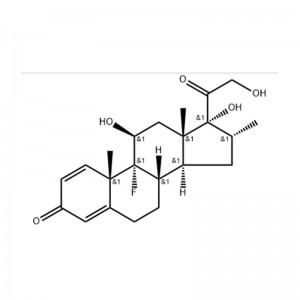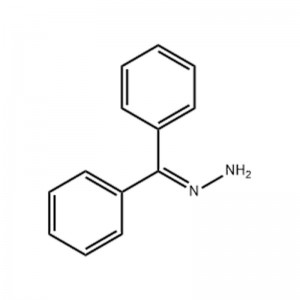
Products
Dexamethasone
Structural Formula

Physical
Appearance: white powder
Density: 1.1283
Melting point: 262-264°C
Boiling point: 568.2±50.0°C
Safety Data
Hazard category: General goods
Application
It is mainly used for anti-inflammatory and anti allergic. It is suitable for rheumatoid arthritis and other collagen diseases.
Dexamethasone (DXMS) was first synthesized in 1957 and is listed in the WHO Essential Medicines Standard List as one of the essential medicines for basic public health systems.
On June 16, 2020, WHO said that preliminary clinical trial results in the United Kingdom showed that dexamethasone can save lives in patients with severe neocoronary pneumonia, reducing mortality by about one-third for patients on ventilators and by about one-fifth for patients on oxygen only.
Dexamethasone is a synthetic corticosteroid that can be used to treat a wide range of conditions, including rheumatic diseases, certain skin conditions, severe allergies, asthma, chronic obstructive pulmonary disease, righteous laryngitis, cerebral edema, and possibly in combination with antibiotics in patients with tuberculosis. It has a pregnancy rating of C in the United States, which requires an assessment that the effectiveness of the drug outweighs the side effects before it can be administered, and a rating of A in Australia, which indicates that it is commonly used in pregnant women and that there is no evidence of fetal harm.
Pharmacological effects
Dexamethasone, also known as flumethasone, fluprednisolone, and dexamethasone, is a glucocorticoid. Its derivatives include hydrocortisone, prednisone, etc. Its pharmacological effects are mainly anti-inflammatory, anti-toxic, anti-allergic and anti-rheumatic, and it is widely used in clinical practice. Its plasma T1/2 is 190 minutes and tissue T1/2 is 3 days. The peak blood concentration of dexamethasone sodium phosphate or dexamethasone acetate reaches at l hour and 8 hours respectively after intramuscular injection. The plasma protein binding rate of this product is lower than that of other corticosteroids. The anti-inflammatory activity of 0.75 mg is equivalent to 5 mg of prednisolone. Adrenocorticosteroids, anti-inflammatory, anti-allergic and anti-toxic effects are stronger than that of prednisone, and the effects of sodium retention and potassium excretion are very light.
1. Anti-inflammatory effect: It can reduce and prevent the tissue response to inflammation, thus reducing the manifestation of inflammation. Hormones inhibit the accumulation of inflammatory cells, including macrophages and leukocytes, at the site of inflammation and inhibit phagocytosis, release of lysosomal enzymes, and synthesis and release of chemical mediators of inflammation.
2. Immunosuppressive effects: including preventing or inhibiting cell-mediated immune responses, delayed allergic reactions, reducing the number of T lymphocytes, monocytes, and eosinophils, decreasing the binding ability of immunoglobulins to cell surface receptors, and inhibiting the synthesis and release of interleukins, thereby reducing the conversion of T lymphocytes to lymphoblasts and attenuating the expansion of primary immune responses. It decreases the passage of immune complexes through the basement membrane and reduces the concentration of complement components and immunoglobulins.
It is readily absorbed from the GI tract, with plasma T1/2 of 190 minutes and tissue T1/2 of 3 days. Peak blood concentrations are reached at 1 hour and 8 hours after intramuscular injection of dexamethasone sodium phosphate or dexamethasone acetate, respectively. The plasma protein binding rate of this product is lower than other corticosteroids, and the anti-inflammatory activity of this product 0.75 mg is equivalent to 5 mg of prednisolone.








